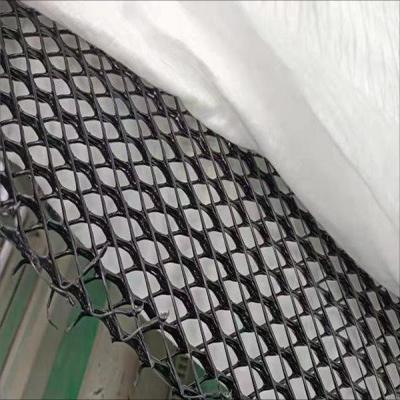Composite drainage network It has very good drainage performance, tensile strength and corrosion resistance, and is commonly used in road construction, tunnel engineering, landfill and water conservancy projects.
1. Preparation before construction
1、Base layer treatment: Before laying the composite drainage net, the base layer should be thoroughly cleaned to ensure that there are no hard protrusions such as gravel and blocks on the surface, and the flatness and compaction required by the design should be met. Flatness not greater than 15 mm, The compaction degree should meet the engineering design standards. The surface of the base layer should be kept dry to avoid the influence of moisture on the performance of the drainage net.
2、Material inspection: A comprehensive inspection of the composite drainage network should be carried out to ensure that there is no damage, no pollution and meets the design requirements. It is necessary to check the core part of the drainage net to ensure that its three-dimensional structure is complete and there is no deformation or damage.
3、Weather conditions: When laying the composite drainage network, the outdoor temperature should be 5 ℃It will be carried out under weather conditions above, wind force below level 4, and no rain or snow to ensure the construction quality.
2. Laying and overlapping requirements
1、Laying direction: The composite drainage network must be laid down the slope to ensure that the length direction is along the direction of water flow. For long and steep slopes, special attention should be paid to using a complete length of material roll at the top of the slope to avoid affecting the drainage effect due to cutting.
2、Obstacle treatment: When encountering obstacles (such as discharge pipes or monitoring wells) during the laying process, cut the drainage net and lay around the obstacle to ensure that there is no gap between the obstacle and the material. When cutting, the lower geotextile and geonet core of the composite drainage net should come into contact with obstacles, and the upper geotextile should have enough margin to fold back under the drainage net to protect the exposed geonet core.
3、Overlapping mode: the overlapping part of the adjacent edges in the length direction of the composite drainage network is at least 100 mm, Also use HDPE Plastic belt binding, the binding belt should be located at the heavy StackThe shaft of at least one geonet is intermediate of the portion and passes through the shaft of the at least one geonet. The joint binding spacing along the side slope is 150 mm, The binding spacing between the joints at both ends of the anchor ditch and the bottom of the landfill is 150 mm。 The color of the overlap part should be white or yellow for easy inspection.
4、Upper geotextile treatment: the upper geotextile is the least heavy Stack 150 mm, The lower geotextile should be completely overlapped. The upper geotextile can be fixed together by sewing or welding. At least one row of double-thread needles should be used at the joint, and the sewing thread should be multiple strands, and the minimum tension should not be less than 60 N, It must also have chemical corrosion and ultraviolet resistance comparable to geotextiles.
3. Backfilling and compaction
1、Backfill materials: After the drainage network is laid, backfill treatment should be carried out in time. Backfill materials should be made of well-graded gravel or sand, and large stones should not be used to avoid damaging the drainage net.
2、Layered compaction: The backfill material should be layered compaction, and the thickness of each layer should not exceed 30 cm。 During compaction, light mechanical or manual methods should be used, and excessive pressure should not be applied to the drainage network. The compacted backfill layer should meet the density and flatness required by the design.
IV. Construction acceptance and maintenance
1、Acceptance content: After the construction is completed, the laying quality of the composite drainage network should be comprehensively accepted, such as the laying direction of the drainage network, overlap quality, compactness and flatness of the backfill layer, etc. Also check that the drainage system is unobstructed and ensure that the drainage effect is achieving the desired goal.
2、Maintenance management: During use, the composite drainage network should be inspected and maintained regularly. The inspection contents include the integrity of the drainage network, the tightness of the overlapping parts and the drainage effect. If problems are found, they should be dealt with in time, and the stability and durability of the engineering structure should not be affected.
Post time: Jan-14-2025




